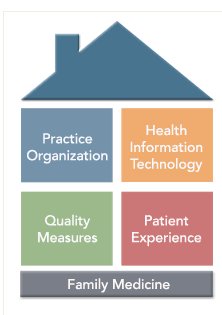The medical home is reform without objections, so far


It's called the medical home. (Picture from the American Academy of Family Physicians.)
Physicians have been talking up the concept since the 1960s, and at its heart it is pretty simple. Charge for wellness and create a team, headed by a physician, that can deliver it.
When people like Larry Green, who heads the American Board of Family Medicine, talk about moving toward a "blended payment" model he's advocating for this team approach to care.
Many doctors' groups support the medical home, but getting from here to there is not easy. Doctors are basically being asked to create a new business, with a new set of employees, and to do this they need start-up capital.
The AAFP magazine Family Practice Management published an article last month with 10 suggested steps for getting that capital.
These start with using existing medical codes to generate more revenue from each patient visit, hiring more nurses and medical assistants, then using these people to increase the number of patients you "see" each day. Wash, rinse, repeat.
If this sounds like gaming the system to generate revenue, it reads like this to me, too. But this revenue has a purpose. The article suggests that capital go into an Electronic Health Record (EHR) system, a "patient portal" through which customers access health data, and links to other helpful electronic resources.
One idea of the $19.2 billion HITECH stimulus cash is that it helps doctors pay for these computer resources so they don't need to game the system to get the money. But they still have to build scaled businesses.
Only after doctors have their office and systems right should they focus on high-cost patients, the article continues. A lot of alligators need to be slain before you drain this swamp.
From the patient point of view, you're going to be given a lot more control over your care, you're going to have a lot more appointments with people other than the doctor, but you're going to get more face time with people trained to help you.
It's that face time that can end disputes like the present one over pap smears and other tests. You will have people you can discuss these issues with, people who have access to your medical records, people who will have the time to listen to you as well as talk.
Now that you know the good news, here is the bad news:
- The financial success of a medical home is based on nagging. You get the data, you get access to the people, but money is only saved when you take the advice.
- It takes money and business transformation to get from here to there. Running a team takes money and organization. Either doctors become businessmen or go to work for people who are. Either they buy and build systems they need or they associate with others who have them.
A health policy based on the medical home is going to be a lot more intrusive than the present fee-for-service model. The team will know if you smoke, how much you drink, what you eat, even what you're likely to die of, based on a whole lot of data.
If the medical home is to save money, and lives, that team will need power to enforce what's good for you. It could come from an adjusted insurance rating, based on your observed lifestyle, with the higher fee going to your medical home.
Or the medical home needs the power to force you out for non-compliance.
The medical home, in the end, offers the promise of lower costs and personal attention, in exchange for your willingness to be bound by your doctor's advice on what's good for you.
Do you still like the medical home?